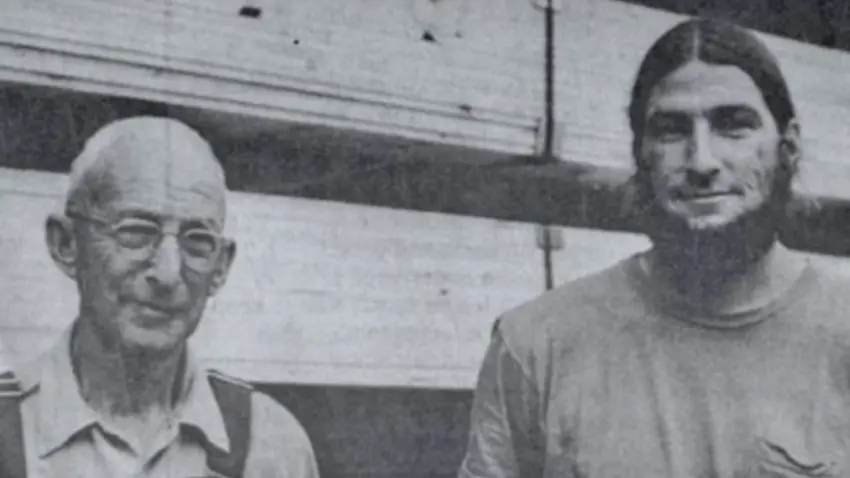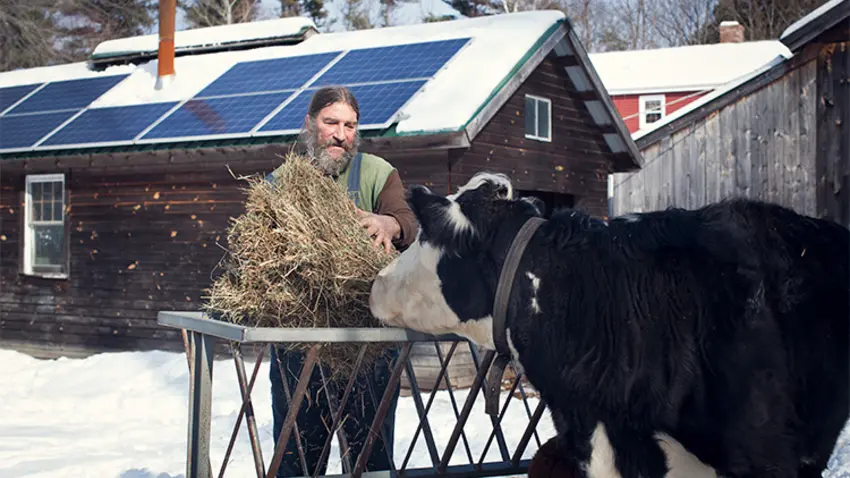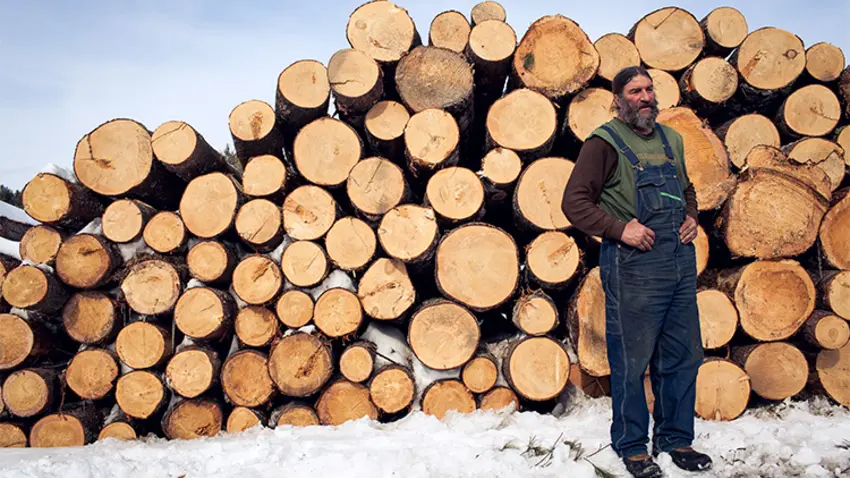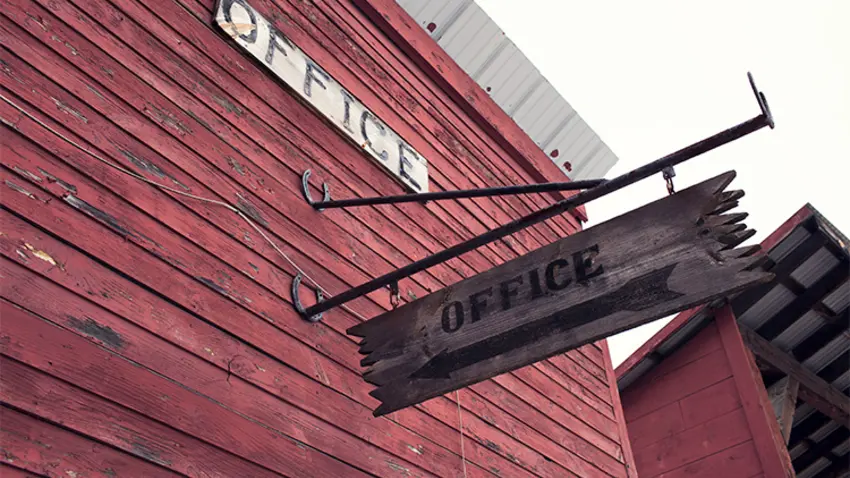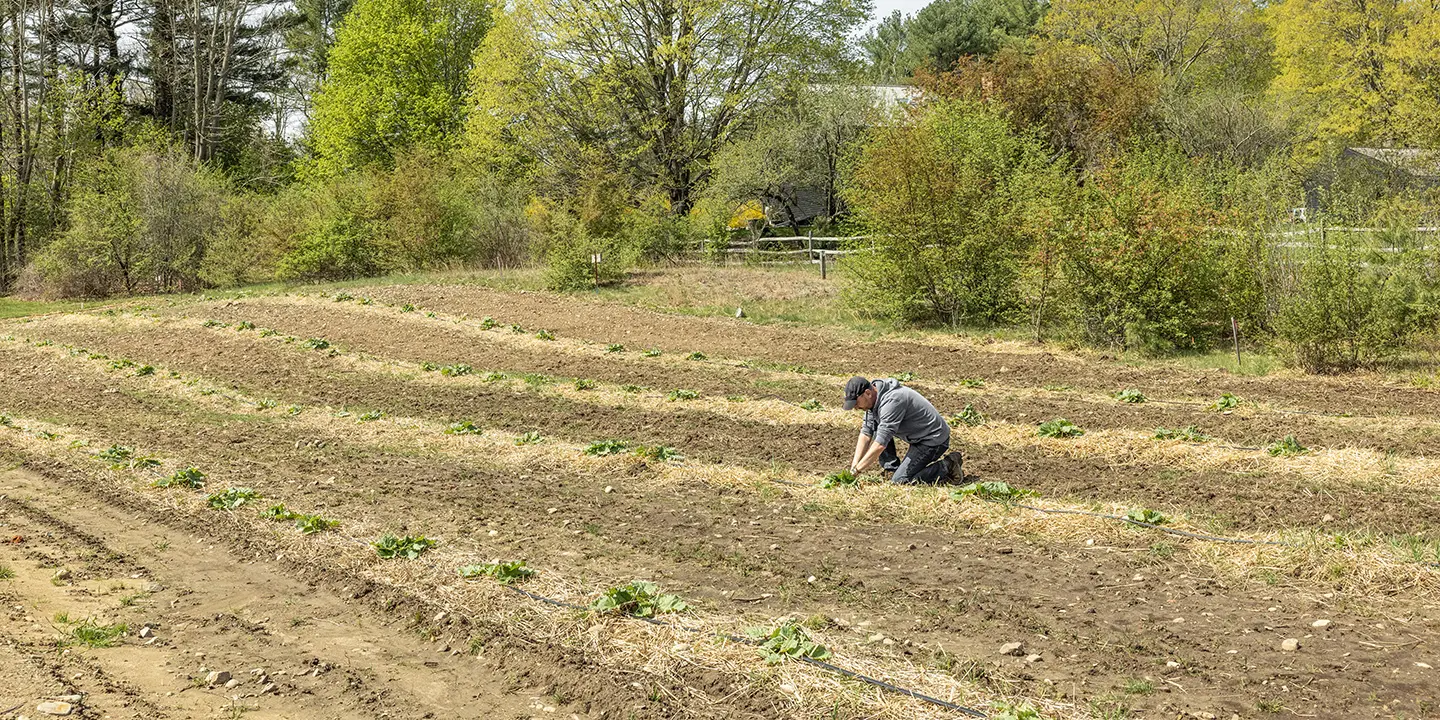
Rooted
The pull of forests, fields & family
For one, it’s the same land. For the other, it’s the same dream. For both, it’s a natural way to make a living — and a life. Meet Justin Chase, MBA ’09, a 12th-generation family farmer, and Thomas Wilkins ’81, the eighth-generation operator of a family-owned sawmill.
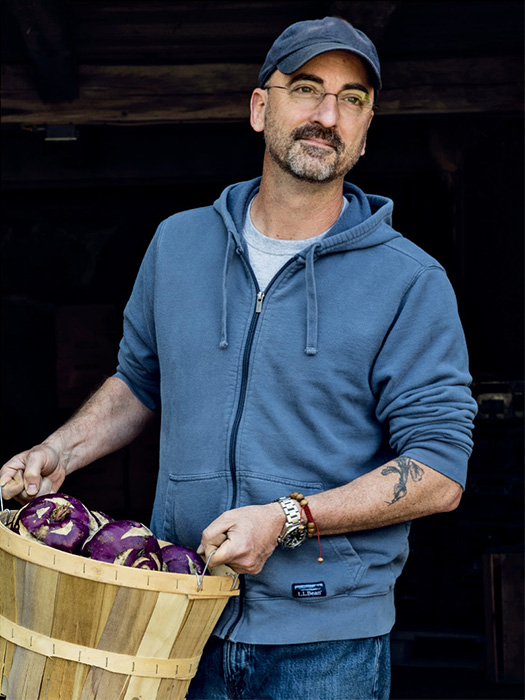 TRUE NORTH
TRUE NORTH
“We’ll walk and talk together, how’s that sound?” Justin Chase, MBA ’09 is on the phone in his greenhouse. While trellising the season’s new raspberry growth, he shares his family history.
Since 1683, the Chases owned and operated Arrowhead Farm in Newburyport, Mass. Like three centuries of relatives, he worked the land growing up. After earning his bachelor’s degree in conservation biology, he became a marine biologist for Boston-based Earthwatch. In 2018, Chase’s father called. Could he help with the farmers markets?
“I discovered the farm was in disarray — and so was my dad,” says Chase, whose two young sons joined him to pitch in. “It was heartbreaking to see the place so run down.”
And, after three seasons, it was clear they had lost the fight. His dad sold the land. However, the new owners did not have rights to the Arrowhead Farm name or business.
That year, says Chase, “It was clear I had fallen in love with farming all over again, but no longer had a farm. What do you do with that?”
New Growth
In 2019, Chase and his wife, Jamie, bought a five-acre plot of land in Boxford. Naming it Arrowhead Farm didn’t feel right. They chose North of Boston, a tribute to Robert Frost’s second book of poetry.
“It’s about small farms, New England life and the market we serve,” explains Chase, who’s fond of quoting Frost, Ralph Waldo Emerson and other local literary lights.
The return to real ingredients was a revelation. “People forget how good a potato can taste,” he says. “You don’t even think about the taste of a potato; you think about the stuff you put on top of it.”
Taste. One of the biggest benefits of eating local. “Factory farms” must consider packaging, transport and other elements that affect how produce will arrive and, ultimately, look on a shelf.
“We produce food that’s meant to be eaten, not shipped,” Chase says of growing heirloom varieties, which are naturally more resistant to pests and are softer, sweeter, juicier.
Yield is everything to a small farm. The Chases aim to optimize theirs by turning multiple crops throughout the year and growing crops among crops. For example, seeding an annual crop such as beets between rows of a perennial crop like grapes, once the latter are harvested. The plan is to do in five acres what others do in 20. In addition to fruits and veggies, they raise heritage-breed pork as well as beef at a friend’s farm.
Today, North of Boston spreads its bounty through seasonal and year-round farmers markets and offers home delivery to 48 towns on Boston’s North Shore. They also donate a portion of their produce to communities that might otherwise go without. Chase hopes, in 2022, to open his farm to the public, complete with a restored 1685 barn that will resemble a 1920s- or ’30s-style farm stand.
Digging into his new landscape unearthed a learning curve or two: new practices, new equipment and, in one case, discovering the hard way which areas are prone to flooding. It’s all part of the experience, says Chase: “We’re getting more familiar with each other, this land and me.”
It is land that Chase is committed to managing intentionally. He’s seen what corporate farming — “Big Ag” — does to soil and food systems.
“I understand it, and I don’t want to fault anyone, but I don’t like what I see,” he says. “I know there’s a better way.”
Studying conservation biology taught him that when a system is created with sustainability in mind, nutrient and resource management become easier, quality increases, yields increase, yield per acre increases. So Chase set out to build an infrastructure around those goals. That included working with the National Resource Conservation Service, a division of the U.S. Department of Agriculture, to earn the designation “USDA Conservation Farm.”
“It just makes sense,” he says. Those raspberries he’s trellising? Growing them in the greenhouse increases yield by about 500%, uses far less water, precludes the need for pesticides and has less impact on the soil.
A Taste for Entrepreneurship
To complement his biology background and lifetime of farming experience, Chase pursued a graduate degree. “People think an MBA is for someone who’s going to wear a suit, work in a big building. Doesn’t need to be.”
He soaked up the lessons in finance, e.g., do I borrow for this now or bootstrap it with revenue earned? And he found his North Star for business decision-making in a course called Managing Collaborative Relationships. Embracing the proverb “a rising tide lifts all boats,” Chase operates North of Boston as an aggregate farm that supports everyone involved. The food he buys comes from farmers he knows and trusts — relationships often sustained over generations. With nearly every move, he tries to help a partner rise right along with him.
More Than ‘A Pretty Tomato’
The global pandemic sprouted a massive acceleration for North of Boston. To meet demand, the farm built out in one year what had been planned for five.
“Before 2020, it felt like people appreciated local food. They liked to go to a farm stand or farmers market and buy a pretty tomato, a couple ears of corn, socialize — it was a nice scene,” he says. “But with COVID, suddenly they’re buying food they eat every day, and that’s a big distinction. I feel relevant again.”
Small farms have largely operated in a shadow economy since the advent of the North American Free Trade Agreement in the early 1990s, Chase explains. He’s grateful for the newfound (or rediscovered) sentiment that people want to support local farmers, but he says it’s backward: Local farmers want to support their communities.
“You can be a functional and contributing member of your local food system without being a 100-acre farm,” he says. “You can support your customers, support other farmers, and still grow on a small, thoughtful scale. And you can do it while helping other people along the way.”
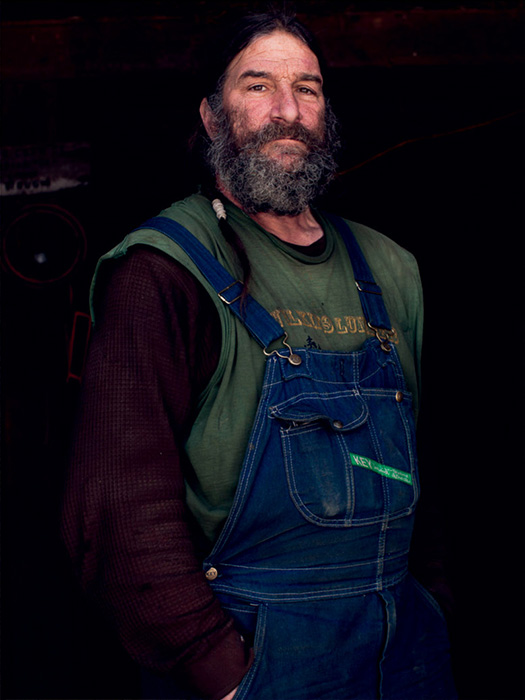 LOGGING A LEGACY
LOGGING A LEGACY
About 50 miles away from North of Boston farm, Thomas A. Wilkins ’81 has just finished making a delivery. As the only employee at his Milford, New Hampshire-based sawmill with a commercial driver’s license, he spends part of many days traveling the back roads of New England.
Like Chase, Wilkins grew up on land cultivated by the same family for generations. Sawdust, he says, is in his veins.
A Seedling is Planted
Wilkins’s father was a teacher who spent summer “vacations” building and remodeling homes. In 1972, at age 12, Wilkins spent his own break from school assisting his dad. Their final project was putting a new roof on a building at the family sawmill. Summer wasn’t quite over, so the young man thought, “Now what?”
“My grandfather offered me a job there for two dollars an hour, and I told him, ‘Well now, that’s better than what Dad pays me!’”
He was all in — and spent weekends and summers at the sawmill through high school. Even while attending Bentley, he returned home during every break. At one point, knowing where his future lay, Wilkins questioned the value of a college degree. Grandpa told him to keep studying.
Branching Out
Wilkins’s great-great-great-grandfather, Frank Hartshorn, was the third generation to live on the land — and the first to recognize a bigger opportunity in the sawmill. Until then, the family of dairy farmers had used it only during the offseason. Hartshorn’s daughter and her husband, Aaron Wilkins, made it a full-time enterprise. That included acquiring additional timberland — more than 1,000 acres worth — and upgrading to a steam-powered mill.
When Aaron died unexpectedly at age 56, his sons, Harold and Aaron, returned to help their grandfather. Throughout the decades, the mill endured the Great Depression and great destruction. Between a major fire and strong hurricane winds, the family lost hundreds of acres of timber — and the mill itself. Yet they persisted.
By the time Wilkins was old enough to make a few bucks doing odd jobs around the mill, it was operating as Wilkins & Son. Ownership then passed to a seventh generation: Wilkins’s second cousin, Robert.
Wilkins was a student of his family’s rich history and a future steward of its land. But first, that degree.
Major Pivot
While heeding the advice to stay in college, Wilkins did change majors — but not until his junior year. Some warned there was no way he could switch from accounting to business management and still finish in four years.
“I said, ‘Watch me!’” he recalls.
The family tenacity, and a wise use of elective credits, enabled Wilkins to graduate on time — with not only a BS in management, but also an associate’s degree in accounting.
When he returned to the mill in 1981, it was full time. He took over the books but yearned to be elsewhere: among the logs. As his role grew, Wilkins married, built a house and farm on 19 acres of land and started a family. He became his second cousin’s business partner and, ultimately, the sole owner of Wilkins Lumber Company.
According to the U.S. Department of Agriculture, New Hampshire is the second-most forested state in the nation. But the landscape around the family’s property has certainly changed since 1808, when E. L. Hartshorn built his small, water-powered sawmill by a babbling brook on the family farm.
“People like to say this is rural,” says Wilkins, referring to the newest residents of an area that has largely become a bedroom community for Boston. “But it’s not the country, it’s suburbia.”
A satellite view of the Amherst area on Google Maps illustrates the shift from rural to suburban. But large swaths of green remain. A few years ago, disheartened by urban sprawl, the Wilkins family put nearly 90% of their land into conservation.
The move had tax benefits and so much more: preserving wildlife habitat and preventing luxury subdivisions and big-box complexes.
Other timberland owners in the region have taken the same route, helping ensure that future generations have forest to enjoy. That bodes well for post-pandemic life.
“I definitely see people wanting to spend more time outside,” says Wilkins, whose outdoor bona fides include hiking the entire Appalachian and Muir trails. “Instead of going to the gym, people are taking up trail running and mountain biking.”
Pandemic times have boosted business for Wilkins Lumber Company — a surge that follows a nationwide trend. In May 2021, Bloomberg reported that lumber prices reached a record high and called the increased demand and uncertain supply a “lumber frenzy.”
“I’m busy. Almost too busy,” he says. “I could be sawing 24/7.”
Blazing a Trail
The paradox is not lost on Wilkins: having a deep love of the great, green outdoors and dedicating a career to carving out pieces of the forest. The fact is, cutting timber is integral to land management. This is where selective harvesting comes in.
“You take about a third of the timber — some of the best, some of the worst. And you open areas in the forest that will help the next generation of trees to come up,” explains Wilkins, likening the process to farming, where you might pull out a third of your carrot plants to help the rest grow better. “Over time, the quality of timber gets better because you’re taking care of it.”
Despite his passion for nature and the work, at 62, Wilkins is bracing for the day he won’t be able to handle the physical demands of cutting lumber. A long-time employee has committed to keep the sawmill running. And his youngest son has a renewed interested in joining, which means Wilkins Lumber Company will pass, in part, to a ninth generation.
He has even spotted the grandchildren picking up bits around the yard — a sign the 10th generation isn’t far behind.
